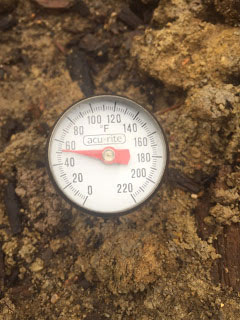Adapted by Deryn Davidson from the CO-Horts blog originally authored by Eric Hammond, CSU Extension Adams County
When is the right time to plant vegetables?
Appropriate planting times for vegetables are based on both air and soil temperatures. Air temperature is fairly straightforward. While cool season crops will tolerate varying degrees of cold weather, most warm season crops, like tomatoes, squash and peppers are tender – meaning they will not tolerate a frost. The average frost dates (first and last of the year) along the Front Range are October 15th and May 15th. It’s not difficult to look at the forecast and see if there is potential for freezing temperatures.
However, even if the air temperature is not prohibitively cold, you also have to take soil temperatures into account. During wet springs, the soil becomes saturated and it will be slower to warm, as more energy is needed to warm both the solid components of the soil and the water the soil is holding.
What is the correct soil temperature?

If soil is too cold seeds may not germinate and transplants may be slow to establish and grow. Ideal soil temperatures range from 45°F for crops like spinach or Fava beans to 70°F for many squash and melons. Tomato transplants prefer a temperature between 60 -65°F.
How can I measure the soil temperature?
Soil temperature can easily be measured with a thermometer. They make specialized soil thermometers which you can purchase at many local garden centers or online. A meat thermometer can also be used, though it is recommend that you designate it as your full-time soil thermometer, retiring it from duty in the kitchen. To measure the soil temperature for plant growth, insert the thermometer about 4 inches into the soil. Temperature should be measured early in the morning, when the soil is its coolest, and you may want to take measurements from several locations.
Can I speed up the warmth of my soil?
There are several ways you can speed the warming of soil in the spring, ranging from building raised beds to covering your beds with plastic.



